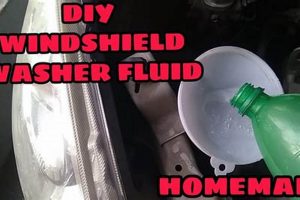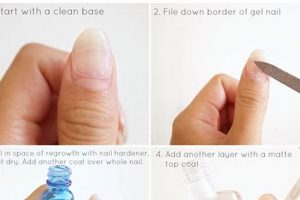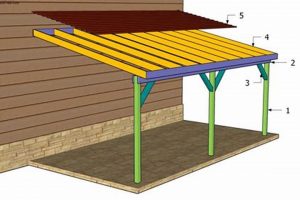The practice of applying window film to vehicle glass by individuals, rather than professional installers, constitutes a form of automotive customization. This process typically involves the purchase of aftermarket film, cutting it to fit the window dimensions, and adhering it to the interior surface of the glass. For instance, a car owner might purchase a roll of window film online, then use a heat gun and squeegee to apply it to their car’s side windows in their garage.
Engaging in this type of project can offer cost savings compared to professional services. Furthermore, it grants individuals greater control over the specific type of film used and the timing of the installation. Historically, it has been a popular method for vehicle owners seeking to enhance privacy, reduce solar heat gain, and improve the aesthetic appearance of their automobiles.
Understanding the tools, techniques, and potential challenges associated with this practice is crucial for achieving satisfactory results. The subsequent sections will delve into the essential materials, preparation steps, application methods, and common pitfalls to avoid in order to achieve a professional-looking finish.
Tips for Successful Automotive Window Film Application
Achieving a professional-quality finish when applying aftermarket window film requires meticulous attention to detail and adherence to best practices. The following tips offer guidance to maximize success and minimize potential issues.
Tip 1: Surface Preparation is Paramount. Thoroughly clean the interior of the window using a dedicated glass cleaner and a lint-free cloth. Any remaining dirt, debris, or adhesive residue will compromise the film’s adhesion and create visual imperfections.
Tip 2: Precise Cutting is Essential. Employ a sharp blade and a straight edge to cut the film slightly larger than the window dimensions. This allows for fine adjustments during the application process and ensures complete coverage.
Tip 3: Use a Quality Slip Solution. Apply a generous amount of slip solution, consisting of water and a small amount of baby shampoo or a dedicated film application solution, to both the window and the adhesive side of the film. This allows the film to be repositioned easily and prevents premature adhesion.
Tip 4: Proper Squeegee Technique is Critical. Use a hard card squeegee, wrapped in a soft cloth, to remove air bubbles and excess slip solution. Start from the center of the window and work outwards, overlapping each stroke to ensure complete contact.
Tip 5: Heat Shrinking for Curved Surfaces. For curved windows, utilize a heat gun to gently shrink the film to conform to the glass. Apply heat evenly and in short bursts to avoid overheating and damaging the film.
Tip 6: Patience is a Virtue. Allow sufficient drying time, typically 24 to 48 hours, before rolling down the windows. This allows the adhesive to fully cure and ensures a long-lasting bond.
Tip 7: Inspect for Imperfections. Carefully examine the finished installation for any remaining air bubbles, creases, or edge imperfections. Address any issues promptly to prevent them from worsening over time.
Following these guidelines will significantly increase the likelihood of a successful outcome, resulting in improved aesthetics, enhanced privacy, and reduced solar heat gain.
The following section will discuss common problems encountered during window film application and provide solutions for addressing them.
1. Film Quality and Automotive Window Tinting
Film quality represents a foundational element within the realm of aftermarket automotive window tinting projects. The selection of film directly influences the ease of application, the longevity of the installation, and the overall performance characteristics of the tinted windows. Inferior films often exhibit inconsistencies in thickness, adhesive properties, and UV rejection capabilities, directly impacting the outcome of a do-it-yourself (DIY) application. For example, a low-grade film may tear easily during installation or develop bubbles and creases that detract from the vehicle’s appearance, even with meticulous application techniques. Cause: Selecting a higher quality tint films for DIY, the effect is a long lasting tint.
The importance of film quality extends beyond aesthetic considerations. High-quality films typically incorporate advanced technologies, such as multi-layer construction and specialized coatings, to enhance their performance. These films provide superior solar heat rejection, reducing the need for air conditioning and improving fuel efficiency. Furthermore, they offer enhanced UV protection, safeguarding the vehicle’s interior from fading and cracking, and protecting occupants from harmful UV radiation. Practical use in DIY can have an actual effect on these elements.
In summary, film quality serves as a critical determinant of success in self-performed auto window tinting. Selecting a high-grade film mitigates installation challenges, maximizes performance benefits, and ensures a durable, aesthetically pleasing result. Conversely, economizing on film quality often leads to unsatisfactory outcomes, necessitating rework and negating potential cost savings. Film quality dictates the outcome of the project.
2. Surface Preparation
Surface preparation constitutes a critical and often underestimated phase in the execution of automotive window film application. The adherence and appearance of the film are directly contingent on the thoroughness of this initial step. Neglecting this aspect can lead to a host of issues, compromising the final result.
- Glass Cleaning
Meticulous glass cleaning is paramount. The presence of dirt, dust, grease, or adhesive residue on the window surface prevents proper film adhesion. Specialized glass cleaners designed for automotive use should be employed, followed by wiping with lint-free cloths. Repeating the cleaning process may be necessary to ensure a completely clean surface. Failure to adequately clean the glass results in bubbling, peeling, and a generally unsatisfactory appearance.
- Contaminant Removal
Embedded contaminants, such as paint overspray or tree sap, require more aggressive removal methods. Clay bars or specialized detailing products can be used to gently lift these contaminants from the glass surface without causing scratches. Thorough inspection of the glass after cleaning is crucial to identify and address any remaining imperfections. Neglecting this step can create visible defects beneath the applied film.
- Edge Preparation
The edges of the window must be clean and free of debris to ensure a seamless film application. Using a soft brush or detailing tool, remove any accumulated dust or grime
from the window seals and edges. This prevents the film from lifting or peeling along the edges, which is a common point of failure. Addressing edge preparation contributes to a more professional and durable outcome. - Drying and Inspection
After cleaning, the window surface must be completely dry before applying the film. Use a clean, dry microfiber cloth to thoroughly dry the glass, paying particular attention to edges and corners. A final inspection under bright light is recommended to identify any remaining streaks, spots, or contaminants that may have been missed during the initial cleaning. Ensuring a completely clean and dry surface is essential for optimal film adhesion and a flawless finish.
The interplay between these facets of surface preparation directly determines the success of any self-performed automotive window film project. Proper execution of these steps mitigates potential issues, enhances the longevity of the film installation, and contributes to a professional-looking aesthetic. Therefore, dedicating adequate time and attention to surface preparation is a worthwhile investment in achieving a satisfactory and durable result.
3. Cutting Precision
Cutting precision forms an indispensable component of successful aftermarket auto window film application. The accuracy with which the film is cut to match the window’s dimensions directly impacts the final appearance and functionality of the tinted windows. Imprecise cuts can lead to visible gaps, overlaps, or distortions, detracting from the vehicle’s aesthetic appeal and potentially compromising the film’s performance. For instance, if the film is cut too short, gaps may appear around the window edges, allowing sunlight to penetrate and negating the film’s intended purpose of reducing heat and glare. Conversely, an oversized cut can result in overlaps that create unsightly wrinkles and bubbles, hindering visibility and potentially leading to premature film failure. Cause and Effect: Sloppy cutting equals a poorly applied tint.
Furthermore, cutting precision extends beyond simply matching the overall dimensions of the window. It also involves accurately replicating any curves, angles, or irregularities in the window’s shape. Many vehicle windows feature complex curves, particularly in the rear window and side windows. Failure to account for these curves during the cutting process can result in significant distortions and wrinkles during film application. Professionals often use specialized software and cutting plotters to achieve precise cuts, particularly for complex window shapes. However, individuals undertaking self-installation must rely on careful measurements, templates, and meticulous hand-cutting techniques to achieve comparable results. Importance: without precision, there is poor tint.
In conclusion, cutting precision represents a fundamental element in the overall quality and success of a self-performed automotive window film project. Neglecting this aspect can lead to visual imperfections, compromised film performance, and ultimately, a less-than-satisfactory outcome. Achieving precise cuts requires careful planning, accurate measurements, and the use of appropriate tools and techniques. While challenges may arise, particularly when working with curved windows, prioritizing cutting precision is essential for achieving a professional-looking and durable window film installation.
4. Application Technique
The efficacy of any “diy auto tint” endeavor is intrinsically linked to the application technique employed. Regardless of film quality or surface preparation, improper application invariably leads to substandard results, characterized by visual imperfections and compromised functionality. The following facets delineate critical aspects of application technique for achieving a professional-quality finish.
- Slip Solution Application
The appropriate application of a slip solutiontypically a mixture of water and mild detergentfacilitates film positioning and prevents premature adhesion. A generous and even coating of slip solution on both the window surface and the adhesive side of the film is essential. Insufficient slip solution results in uneven adhesion and difficulty in removing air bubbles. Conversely, excessive slip solution can hinder the squeegeeing process and prolong drying time. A balanced approach is crucial for optimal film manipulation and adhesion.
- Squeegeeing Technique
The squeegeeing process is instrumental in removing air bubbles and excess slip solution, ensuring a smooth and uniform film application. A hard card squeegee, often wrapped in a soft cloth to prevent scratching, is used to apply consistent pressure from the center of the window outwards. Overlapping strokes are necessary to eliminate all air pockets and achieve full film contact with the glass surface. Improper squeegeeing can lead to trapped air bubbles, creases, and a generally unprofessional appearance.
- Heat Gun Application (where applicable)
For curved windows, a heat gun is employed to soften the film and allow it to conform to the window’s contours. This requires a delicate balance of heat application and film manipulation. Excessive heat can damage the film, causing it to shrink excessively or develop a “frosted” appearance. Insufficient heat results in wrinkles and creases that cannot be smoothed out. The proper technique involves applying heat evenly and gradually, allowing the film to relax and conform to the window’s shape without damage.
- Edge Sealing
Proper edge sealing is crucial for preventing film lifting and ensuring long-term adhesion. After the film has been applied and squeegeed, the edges should be carefully inspected and trimmed as needed. A heat gun can be used to gently shrink the film around the edges for a secure and seamless finish. Failure to properly seal the edges can lead to peeling and bubbling, compromising the overall appearance and performance of the window film.
These facets of application technique collectively determine the success or failure of any “diy auto tint” project. Mastering these techniques requires practice and attention to detail. However, the effort invested in developing proficiency in these areas directly translates to a professional-quality outcome, characterized by enhanced aesthetics, improved functionality, and long-lasting durability.
5. Heat Gun Use
Heat gun use represents a critical technique in the successful application of window film to vehicles, particularly when dealing with curved glass surfaces. The controlled application of heat allows the film to conform precisely to the contours of the window, a process essential for achieving a smooth, professional finish. Without proper heat application, the film is likely to wrinkle or bubble, leading to visual imperfections and compromised performance. For example, attempting to apply window film to the curved rear window of a sedan without using a heat gun will almost certainly result in an unsatisfactory outcome.
The connection between heat gun use and automotive window film application lies in the physical properties of the film itself. Window film i
s typically made of a thermoplastic polymer, which softens and becomes more pliable when heated. This allows the film to be stretched and molded to fit complex shapes. However, it is crucial to apply heat evenly and gradually, avoiding excessive heat that can damage or distort the film. Experienced installers use a sweeping motion with the heat gun, maintaining a consistent distance from the film to prevent overheating. The importance of this technique is evident when observing the application process on curved windows, where the heat gun is used to gradually shrink the film to fit the glass perfectly, minimizing the need for cutting and trimming.
Understanding the correct application of heat is paramount for individuals undertaking automotive window film projects. Incorrect heat gun use is a common cause of failure, often resulting in wasted material and the need for re-application. Practicing on scrap pieces of film and experimenting with different heat settings can help individuals develop the necessary skills and techniques. In summary, heat gun use is an indispensable skill for achieving a professional-quality window film installation on vehicles with curved glass, directly influencing the aesthetic appearance and overall performance of the tint.
6. Curing Time
Curing time represents a vital, yet often overlooked, phase in the self-performed automotive window film application process. This period, typically ranging from 24 to 72 hours depending on environmental conditions and film type, allows the adhesive to fully bond to the glass surface. Prematurely manipulating the tinted windows during this interval can disrupt the adhesion process, resulting in bubbling, peeling, or distortion of the film. For example, lowering a freshly tinted window only hours after application may cause the film to separate from the glass along the top edge, necessitating costly rework. This is due to the connection between a wet adhesive surface and applied pressure or movement. The consequence of ignoring the recommended curing time is often a compromised final result.
The importance of curing time stems from the nature of the adhesives used in window film. These adhesives are typically pressure-sensitive, requiring sustained contact with the glass surface to achieve optimal bonding. During the curing process, moisture from the slip solution used during application gradually evaporates, allowing the adhesive to establish a strong, permanent bond with the glass. External factors, such as temperature and humidity, significantly influence the duration of the curing period. Higher temperatures and lower humidity accelerate the evaporation process, while cooler temperatures and higher humidity can prolong it. Understanding these environmental influences is essential for determining the appropriate curing time. A practical instance may involve needing to wait a longer time period on a rainy week to ensure the adhesive bonds appropriately.
In summary, adhering to the recommended curing time is crucial for ensuring the long-term durability and aesthetic appeal of a self-applied automotive window film installation. Neglecting this step can lead to costly repairs and a compromised outcome. While patience may be required, allowing the adhesive to fully cure is a worthwhile investment in achieving a professional-quality finish. The challenges associated with curing time can be mitigated by understanding the environmental factors and film-specific recommendations that influence the process, ultimately leading to a more successful and lasting result.
Frequently Asked Questions About DIY Auto Tint
This section addresses common inquiries and misconceptions surrounding the practice of aftermarket automotive window film installation.
Question 1: What is the typical lifespan of DIY auto tint film?
The longevity of self-installed automotive window film is contingent upon several factors, including film quality, application technique, and environmental conditions. Generally, a professionally applied, high-quality film can last upwards of five to ten years. A comparable DIY installation may achieve a similar lifespan with meticulous preparation and execution. However, factors such as substandard film or improper installation techniques can significantly reduce its longevity.
Question 2: Is it legal to install aftermarket window film on all vehicle windows?
Regulations governing automotive window tinting vary significantly by jurisdiction. Many regions stipulate specific visible light transmittance (VLT) percentages for different windows. Before undertaking a DIY auto tint project, it is imperative to consult local laws and regulations to ensure compliance. Non-compliance can result in fines or the requirement to remove the film.
Question 3: What tools are essential for a DIY auto tint installation?
A successful DIY auto tint project necessitates several essential tools, including a sharp blade, a heat gun, a hard card squeegee, a spray bottle for slip solution, a lint-free cloth, and a measuring tape. Additional tools, such as a detail brush and specialized cutting templates, can further enhance the precision and quality of the installation.
Question 4: What are the common pitfalls to avoid during DIY auto tint installation?
Several common pitfalls can compromise the outcome of a DIY auto tint project. These include inadequate surface preparation, imprecise cutting, insufficient slip solution, improper squeegeeing technique, and excessive heat application. Avoiding these mistakes requires meticulous attention to detail and adherence to established best practices.
Question 5: Can DIY auto tint improve vehicle energy efficiency?
High-quality automotive window film can effectively reduce solar heat gain within a vehicle, thereby decreasing the demand on the air conditioning system. This can lead to improved fuel efficiency and reduced carbon emissions. The effectiveness of the film is dependent on its solar heat rejection properties and the climate in which the vehicle is operated.
Question 6: What is the recommended curing time after DIY auto tint installation?
The recommended curing time for automotive window film is typically between 24 and 72 hours, depending on environmental conditions and film type. During this period, it is crucial to avoid lowering the windows or applying excessive pressure to the film. Allowing sufficient curing time ensures proper adhesion and prevents bubbling or peeling.
In summary, DIY auto tinting presents both opportunities and challenges. Careful planning, adherence to best practices, and awareness of local regulations are essential for achieving a satisfactory outcome.
The following section will discuss considerations for selecting the appropriate film type for specific needs and preferences.
Conclusion
The preceding exploration has illuminated various facets of “diy auto tint”, from material selection and preparation techniques to application best practices and potential pitfalls. A discernible understanding of film properties, surface requirements, and tool utilization emerges as crucial for individuals considering this undertaking. Furthermore, adherence to legal mandates concerning light transmittance is paramount.
While the prospect of cost savings and customization control may appeal to some, the complexity and precision demanded by “diy auto tint” should not be underestimated. Careful consideration of individual skill level, available resources, and potential consequences of suboptimal results is advised. The d
ecision to proceed should be informed by a realistic assessment of capabilities and a thorough understanding of the inherent challenges. This should be taken into consideration before pursuing auto tint on your own.



![Diya Aur Baati Hum: Illuminate Your Home [DIY Guide] The DIY Hub: Creative Crafts, Repairs & Life Hacks Diya Aur Baati Hum: Illuminate Your Home [DIY Guide] | The DIY Hub: Creative Crafts, Repairs & Life Hacks](https://craftingdiycenter.com/wp-content/uploads/2025/07/th-5913-300x200.jpg)



